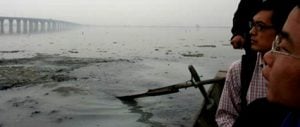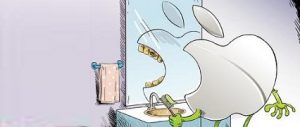On August 31, five Chinese environmental groups published a report that claims Apple’s pollution is spreading as its supply chain expands, presenting a grave threat to China’s environment and public health. chinadialogue’s Beijing editor Liu Jianqiang interviewed one of the main compilers of the report and director of the Institute of Public and Environmental Affairs (IPE), Ma Jun.
Liu Jianqiang: You published a report in January pointing out that Apple has broken its own promises on environmental protection, occupational health and workers’ rights. What has changed since then?
Ma Jun: Unlike last time, this report focuses [exclusively] on Apple’s environmental problems. In our previous report, we covered the environment, occupational health and workers’ rights. A month later, Apple published a progress report on supplier responsibility admitting that 137 workers in its supply chain had been poisoned, but said nothing about environmental issues – so we decided to do more work on Apple’s environmental pollution.
LJ: How did you get hold of the information about Apple’s suppliers?
MJ: One source was the map of pollution data that we already have [IPE has developed China’s first public databases of pollution information] – we went through the database checking who the polluters were, what they produce and who they supply. Another method was first finding out who Apple’s suppliers are, and then checking them against our database.
One example from the report is Kaedar Electronics. Pollution from this company has a major impact on the local community and harms children’s health. How did we find out they are an Apple supplier? Interestingly enough, Apple once sued one of its own managers for taking bribes from suppliers – one of which was Kaedar. So that was a rare piece of evidence. We searched for that company, found that it was recorded in our database, along with lots of public complaints about its pollution. We went to talk to the locals to find out what was happening, and then went to carry out an on-site investigation. I myself went twice, as did [environmental NGO and co-author of the report] Nanjing Green Stone.
Another example is Meiko Electronics in Wuhan. Meiko is one of the world’s largest manufacturers of printed circuit boards. The Taiwanese press keeps a particularly close eye on Meiko, and they’re very well informed – so we kept an eye on the Taiwanese press. They reported that, with the iPad 2 selling well, Apple was in a rush to expand production and take on new suppliers, and that Meiko was one of these. We couldn’t be certain, but we kept watching. Then, after the earthquake in Japan, Wuhan media reported that Meiko’s Japanese headquarters had been badly affected and lots of orders were being shifted to Wuhan – including Apple’s. That local press report wanted to say that this is an important company, that this is a good thing. But it allowed us to confirm that Meiko is an Apple supplier.
Also, Meiko Electronics has long been in our database, and there are lots of pollution records on this company. Meiko in Guangdong is listed year after year as a polluter by the local government, so the name stands out for us. So when we saw Meiko in the context of Apple’s suppliers, we naturally made the link.
LJ: How did you go on to investigate pollution from these suppliers?
MJ: [In the case of Meiko] I went to Wuhan and got in touch with lawyer Zeng Xiangbin of Friends of Nature’s Wuhan branch, and he got in touch with local fishermen. If we hadn’t had them to row us over the lake there, our study on local water pollution wouldn’t have been so effective. I’d done some research in the office to find out about sensitive water systems nearby, and found some workers who had been affected by toxins while working there. Through a number of government departments, we learned about oversight of the company.
The local drainage is quite complicated; the pipes are hard to find. The water authorities had coordinates for waste outlets in a document online, so we eventually tracked it down with GPS. The outlet is shared by Meiko and Chenming Paper, and every day tens of thousands of tonnes of polluted water gets released. You can’t detect the pollution from electronic companies like that just by the look or smell, so we used a third party to test the water. There are pollutants such as copper and nickel which point to the electronics industry, and we found that the copper content of the mud from the bottom of Nantaizi Lake was unusually high – several dozen or even a hundred times higher than that of other lakes, and way above mandated standards.
LJ: During the investigation, were you helped by publicly released government information?
MJ: Yes, we were. The basis of our database is information published by the government, and that information is authoritative. We read information the government publishes on environmental assessments and its responses, which contain regulations on emission of pollutants. If we’re concerned about something, we can request information from the local environmental protection bureau. For example, this time we got information from Wuhan environmental protection bureau.
LJ: You published your first report on Apple in January. In February Apple released a document admitting that workers in its supply chain had suffered industrial injuries. Has Apple improved its behaviour since then?
MJ: Apple’s behaviour hasn't improved at all. It has admitted there are issues in its supply chain, but it hasn’t made any adjustments to its policy, maintaining that “it is our long-term policy not to disclose supplier information” and ignoring questions from environmental groups. Injured workers wrote to Apple three times, but got no response at all. We’ve read that Apple progress report carefully. It says that 36 suppliers had “major violations”, but some of those are taking high agency fees or telling workers what to do during audits. The pollution issues we found are a serious threat to local communities – yet not one of those was included.
Personally I feel that the “black box” audits aren’t doing any good. Under cover of those audits, Apple is able to use polluting companies as suppliers, at the cost of China’s environment and public health, and make excessive profits. On this point, Apple hasn’t changed at all. If there has been any change, it’s been that it has grown even bigger in scale – its size in China now would have been unimaginable before. Taiwan’s industry press says that Kaedar’s parent company has an order for 15 million iPhone 5s alone, and its main manufacturing facilities are in China. Foxconn’s Chengdu operations will make two thirds of all iPad 2s. On May 20, there was an explosion in that company’s polishing workshop, killing three workers and injuring 20. Later, it emerged that the eight-building, 250 mu facility [one mu is around 667 square metres] had been constructed in only 76 days – at those kind of speeds, control of pollution and safety is going to be a huge challenge. How could a supplier like that pass an audit carried out by an Apple vice president? We have cause to be suspicious about Apple’s audit process.
LJ: Have you been in touch with Apple during your investigation?
MJ: We wrote to Apple last week, asking it to confirm: whether or not the companies we mention in the report are suppliers; whether or not Apple is aware of their breaches; and whether or not Apple knows about the repeated complaints. But there was no response. After the poisoning incident last year, we sent a list of questions to Apple in August. Apple didn’t reply until November – and then not to Chinese NGOs, but to an American NGO – saying it could not confirm if the company was a supplier, and that Apple needed the environmental groups to provide more evidence. The NGO responded that a lot of publicly available information showed it was an Apple supplier, and Apple replied that “it is our long-term policy not to disclose supplier information”. And so the door was closed.
LJ: What would you like to see Apple’s customers do?
MJ: After the last report was published, there was some criticism [of Apple] from consumers, but it wasn’t enough. Orders kept coming in, and so Apple put it at the back of its mind. Apple has made the decision to make use of failings in China’s corporate supervision to team up with polluting firms, poison China’s environment and people – and make excessive profits. What we can do is to provide consumers with information. It’s a difficult process, but if they have enough information one day the consumers will make their choice. I believe eventually consumers will reject trendy electronics that have been produced by a company that poisons the environment.
LJ: What made the deepest impression on you during your investigation into Apple’s pollution?
MJ: I was shocked when I saw the huge quantities of dangerous waste produced by Apple suppliers. One of them creates 110,000 tonnes a year alone. Compare that to the chromium waste in Yunnan that is getting a lot of attention at the moment – in that case, 140,000 tonnes has been sitting around for years, and there’s no way to treat it. But this Apple supplier produces 110,000 tonnes annually, and that’s just one company of many. We don’t know where that waste goes, and that’s a huge risk for China.
Apple’s methods mean there is little chance of that dangerous waste being handled properly. It’s not willing to make its supply chain public; or to let suppliers face public supervision.
LJ: How are other IT brands doing?
MJ: Most have chosen to do things differently from Apple. Take Siemens for instance: it has 10,000 suppliers in China, and managing those is going to be very difficult. And so it has developed software that checks its suppliers against our database of polluting companies – and if there’s a problem, a letter gets sent in the CEO’s name requesting that the supplier explains itself to environmental groups. Nokia, Vodafone and Philips have also all made progress.
LJ: Now that Steve Jobs has resigned, can I ask you to predict whether or not Apple’s policy will change?
MJ: I hope it will, of course. But a corporate culture forms over the long term and, without pressure from all sides, it is unlikely to change.
Liu Jianqiang is the Beijing-based deputy editor of chinadialogue.
Homepage image shows Ma Jun speaking at a chinadialogue event at London's House of Commons in April.






